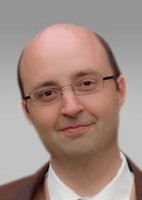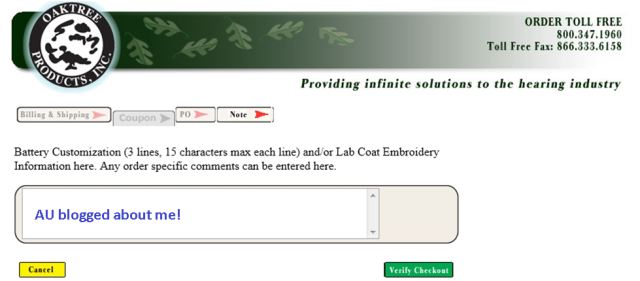 The following is an excerpt from my speech delivered on Friday, April 12, 2013 to nearly 400 audiology & speech pathology students, faculty, family and friends while accepting the 2013 Distinguished Alumnus Award from the Department of Communication Sciences & Disorders at the University of Cincinnati during this year’s Spring Banquet.
The following is an excerpt from my speech delivered on Friday, April 12, 2013 to nearly 400 audiology & speech pathology students, faculty, family and friends while accepting the 2013 Distinguished Alumnus Award from the Department of Communication Sciences & Disorders at the University of Cincinnati during this year’s Spring Banquet.
 I don’t know about you, but when I hear of an individual receiving a Distinguished-Anything Award, I automatically assume this person had their professional life figured out from the beginning. They knew exactly what they were doing, made all the right moves, all the right decisions. To that I say, “Clap, clap! You deserve a plaque!” Now that I am on the receiving end of this kind of recognition, my immediate response is “This is
I don’t know about you, but when I hear of an individual receiving a Distinguished-Anything Award, I automatically assume this person had their professional life figured out from the beginning. They knew exactly what they were doing, made all the right moves, all the right decisions. To that I say, “Clap, clap! You deserve a plaque!” Now that I am on the receiving end of this kind of recognition, my immediate response is “This is  crazy!” You want to know why? You are looking at someone who in the month of May during her senior year of high school had not yet applied to any college because there was never the intention to attend. You are looking at someone who had a first job, second job, NO job, third job, then NO job again. You are looking at someone who never really had her professional life figured out.
crazy!” You want to know why? You are looking at someone who in the month of May during her senior year of high school had not yet applied to any college because there was never the intention to attend. You are looking at someone who had a first job, second job, NO job, third job, then NO job again. You are looking at someone who never really had her professional life figured out.
 In reflecting on my career, I began to realize that I have been successful; and the one thing that I have probably been most successful at is making a lot of bad mistakes. Now, the difference between someone who makes a lot of bad mistakes versus someone who makes a lot of bad mistakes and is fortunate enough to potentially receive the type of recognition I am honored to receive this evening is that in the later situation, I not only made a lot of bad mistakes, I learned from them and moved forward.
In reflecting on my career, I began to realize that I have been successful; and the one thing that I have probably been most successful at is making a lot of bad mistakes. Now, the difference between someone who makes a lot of bad mistakes versus someone who makes a lot of bad mistakes and is fortunate enough to potentially receive the type of recognition I am honored to receive this evening is that in the later situation, I not only made a lot of bad mistakes, I learned from them and moved forward.
Having said that, whether you are in Speech Pathology and/or Audiology, pursuing an undergraduate degree, Masters, AuD, or PhD, the following is some advice to the students in this room from someone who has made her fair share of mistakes.
1. LIFE IS NOT FAIR
 As an undergraduate, I had to work 40-hours a week on campus at a coffee shop every morning before class, in-between classes, and after class while taking a full course load to pay for my tuition, books, and living expenses. Many of my roommates had parents who paid for everything. The fact that many of my roommates had everything paid for did not make them better than me and you know what? The fact that I had to work to pay for my own education didn’t make be better than them either. Those were our individual circumstances. It was what it was, it is what it is, life ain’t fair, get over it.
As an undergraduate, I had to work 40-hours a week on campus at a coffee shop every morning before class, in-between classes, and after class while taking a full course load to pay for my tuition, books, and living expenses. Many of my roommates had parents who paid for everything. The fact that many of my roommates had everything paid for did not make them better than me and you know what? The fact that I had to work to pay for my own education didn’t make be better than them either. Those were our individual circumstances. It was what it was, it is what it is, life ain’t fair, get over it.
2. STOP PLAYING THE BLAME GAME
 “I didn’t know this was going to be on the test!” “My program didn’t offer a course in that.” “The teacher didn’t talk about that in class.” “I wasn’t exposed to a patient with those symptoms so how am I supposed to know what to do?.”….blah, blah, blah. Your college program and your teachers are tools to facilitate your learning. You, and only you, are ultimately responsible for acquiring the knowledge an education is designed to expose you to so make sure you make the most of it. Speaking of teachers….
“I didn’t know this was going to be on the test!” “My program didn’t offer a course in that.” “The teacher didn’t talk about that in class.” “I wasn’t exposed to a patient with those symptoms so how am I supposed to know what to do?.”….blah, blah, blah. Your college program and your teachers are tools to facilitate your learning. You, and only you, are ultimately responsible for acquiring the knowledge an education is designed to expose you to so make sure you make the most of it. Speaking of teachers….
3. (You think) FACULTY IS TOUGH & UNREASONABLE
Wait until you get a boss. And, for those of you chuckling because you are going to be your own boss, wait until you have your own established patient base (or people directly reporting to you).
4. GET OVER THE NOTION THAT YOU WILL NEVER HAVE TO TAKE A TEST AGAIN
 Perhaps you will never have to take another formal examination once you graduate but expect at least one pop quiz at work every day. Understand that your patients will not grade your performance on a curve and there is usually very little opportunity for extra credit. Stay current in reading professional journals, attend conferences, go to presentations to learn from those with first-hand experience, study, and continue to ask questions. These are the things you minimally need to do to remain a good clinician.
Perhaps you will never have to take another formal examination once you graduate but expect at least one pop quiz at work every day. Understand that your patients will not grade your performance on a curve and there is usually very little opportunity for extra credit. Stay current in reading professional journals, attend conferences, go to presentations to learn from those with first-hand experience, study, and continue to ask questions. These are the things you minimally need to do to remain a good clinician.
5. YOU DON’T KNOW EVERYTHING
 You certainly know a lot but don’t lose site of the fact you don’t and won’t know everything, even when considered an expert in an area. If you find yourself in a situation where you start to think you know everything, do me a favor and give the other person the benefit of the doubt rather than acting like a know-it-all or a bully. Kids don’t like a know-it-all or bully, and guess what? Neither will your colleagues.
You certainly know a lot but don’t lose site of the fact you don’t and won’t know everything, even when considered an expert in an area. If you find yourself in a situation where you start to think you know everything, do me a favor and give the other person the benefit of the doubt rather than acting like a know-it-all or a bully. Kids don’t like a know-it-all or bully, and guess what? Neither will your colleagues.
6. LEARN TO LISTEN
There is a reason we have one mouth yet two ears. Speak 50% less and listen 100% more.
7. WEIGH EMPLOYMENT OPTIONS ON YOUR HAPPINESS SCALE RATHER THAN THE PAY SCALE
 Do not use the pay scale as an indicator of your potential job satisfaction. Salary is a form of instant gratification that wears off by the third paycheck. Ignore the pay scale as much as you can and focus on your own happiness scale. What is it that you need to be happy? Do a better job interviewing a company to figure out if they are the right fit for you. When you choose the right work environment, you will be happier. Happier people tend to be more productive and creative. When you are in an environment where you thrive, often times the money will follow. Be patient.
Do not use the pay scale as an indicator of your potential job satisfaction. Salary is a form of instant gratification that wears off by the third paycheck. Ignore the pay scale as much as you can and focus on your own happiness scale. What is it that you need to be happy? Do a better job interviewing a company to figure out if they are the right fit for you. When you choose the right work environment, you will be happier. Happier people tend to be more productive and creative. When you are in an environment where you thrive, often times the money will follow. Be patient.
8. YOU MAKE YOUR OWN LUCK
 Other than the lottery and a few other life situations, you create your own opportunities through hard work and perseverance. When you work hard, more opportunities arise and good things tend to happen. Other people misinterpret that as luck.
Other than the lottery and a few other life situations, you create your own opportunities through hard work and perseverance. When you work hard, more opportunities arise and good things tend to happen. Other people misinterpret that as luck.
9. PAY IT FORWARD
 Give back to your profession. Whether you donate time through volunteering, serving on a committee or writing out a check to support a professional cause, give back as often as you can and in a matter that is meaningful to you.
Give back to your profession. Whether you donate time through volunteering, serving on a committee or writing out a check to support a professional cause, give back as often as you can and in a matter that is meaningful to you.
10. FIND AND PRACTICE BALANCE IN YOUR LIFE
 Work is not everything. Have you heard the phrase “All work and no play makes Jack a dull boy?” It does. The word dull may be defined as “lacking interest or excitement“. If work is all you talk about, people won’t want to hang around with you because you are boring. The word dull can also be defined as “sluggish” or “not sharp“. If you work all the time, you will become ineffective. Find things you enjoy doing outside of work and make time to enjoy them.
Work is not everything. Have you heard the phrase “All work and no play makes Jack a dull boy?” It does. The word dull may be defined as “lacking interest or excitement“. If work is all you talk about, people won’t want to hang around with you because you are boring. The word dull can also be defined as “sluggish” or “not sharp“. If you work all the time, you will become ineffective. Find things you enjoy doing outside of work and make time to enjoy them.
 So, some food for thought for the students out there. Bare in mind, the take home message is not “Do Not Make Mistakes”. It’s inevitable; we all make mistakes and trying to avoid them is in it of itself a mistake. Learning from your mistakes is key to success. The best way to make sure you learn from your mistakes (beyond self-awareness) is to surround yourself with a network of good people who will not only support you, but will also keep you grounded. I had that in my mentor Dr. Robert W. Keith (see below) who was my teacher, my boss, my colleague, my greatest cheerleader but also someone who gave me a kick in the ars when I needed one. I wish all of you the best as you move forward in establishing your very own happy, rewarding careers.
So, some food for thought for the students out there. Bare in mind, the take home message is not “Do Not Make Mistakes”. It’s inevitable; we all make mistakes and trying to avoid them is in it of itself a mistake. Learning from your mistakes is key to success. The best way to make sure you learn from your mistakes (beyond self-awareness) is to surround yourself with a network of good people who will not only support you, but will also keep you grounded. I had that in my mentor Dr. Robert W. Keith (see below) who was my teacher, my boss, my colleague, my greatest cheerleader but also someone who gave me a kick in the ars when I needed one. I wish all of you the best as you move forward in establishing your very own happy, rewarding careers.
-A.U. Bankaitis, PhD, University of Cincinnati, 1991-1995






























![briantaylor-unitron1[1]](https://aubankaitis.files.wordpress.com/2013/03/briantaylor-unitron11.jpg?resize=117%2C150)



